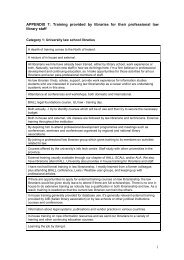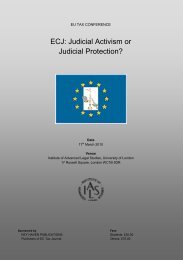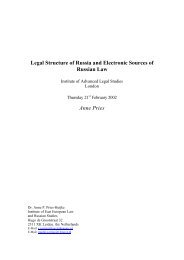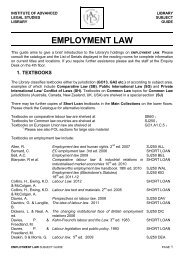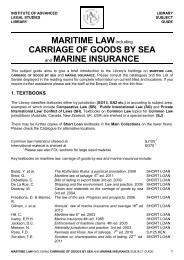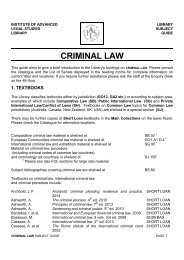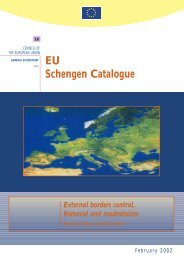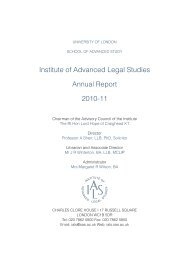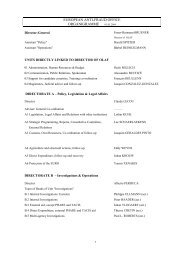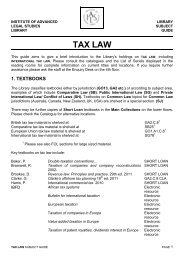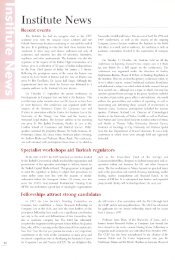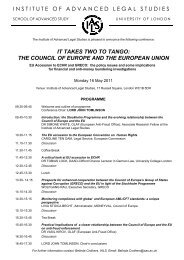a thesis - Institute of Advanced Legal Studies
a thesis - Institute of Advanced Legal Studies
a thesis - Institute of Advanced Legal Studies
Create successful ePaper yourself
Turn your PDF publications into a flip-book with our unique Google optimized e-Paper software.
RULES DETERMINING INTENTION TO CREATE A TRUST. 43<br />
husband. This creates a trust in favour <strong>of</strong> the husband. Tweedalc<br />
v. Tweedak (1878), 7 Oh. D. 633.<br />
5. X. by deed assigns property upon trust for A. for life, and<br />
after her decease for B. for life, and after the decease <strong>of</strong> the survivor<br />
amongst such <strong>of</strong> the children <strong>of</strong> A. and B. then living, in<br />
such manner, shares, times, and proportions as A. and B. jointly,<br />
or the survivor <strong>of</strong> them separately, should appoint, and in case<br />
there should be no such child or children, then upon trust for 0.<br />
for life, and, after his decease, amongst such <strong>of</strong> his children in such<br />
manner, shares, times, and proportions as he should appoint. This<br />
is a trust in favour <strong>of</strong> O.'s children, and upon the death <strong>of</strong> A. and<br />
B. without issue, and failure <strong>of</strong> C. to exercise his power <strong>of</strong> appointment,<br />
all his children are entitled as tenants in common. Wilson<br />
v. Duguid (1883), 24 Ch. D. 244.<br />
6. A. bequeaths to her husband a life interest in certain real<br />
property, and gives him " power to dispose <strong>of</strong> all such property by<br />
will amongst our children." This is a mere power, and not a<br />
trust. In re Weekes' Settlement, (1897) 1 Ch. 289.<br />
ILLUSORY TRUSTS.<br />
An assignment <strong>of</strong> property to trustees in trust to pay debts,<br />
although at first sight it appears to create a trust, is generally not<br />
enforceable by the creditors unless they are parties to it. The<br />
rule was first laid down in Walwyn v. Coutts (1815, 3 Sim. 14),<br />
where it was held that the creditors could not prevent the<br />
revocation <strong>of</strong> the deed. This was expressly followed in Garrard v.<br />
Lauderdak (1831, 3 Sim. 1 ; and 2 Euss. & My. 451), and again<br />
in Acton v. Woodgate (1833, 2 My. & K. 492). The rule was<br />
stated in Bell v. Cureton (1835, 2 My. & K. 503) to have been<br />
adopted "to promote the views and intentions <strong>of</strong> parties"; and<br />
though doubts as to the propriety <strong>of</strong> the decision were sometimes<br />
expressed in former days (e.g., by Knight Bruce, Y.-C., in<br />
Wilding v. Richards (1845, 1 Coll. Ch. B. 659), and by Sugden,<br />
L. C., in the Irish case <strong>of</strong> Simmonds v. Palles (1845, 2 Jo. & Lat.<br />
504)), the rule is now established beyond question. "It appears<br />
to me to be too late now to question the principle <strong>of</strong> Garrard v.<br />
Lauderdak," said James, L. J., in Johns v. James (1878, 8 Ch. D.<br />
744). That case " seems to me to have proceeded upon the plainest



